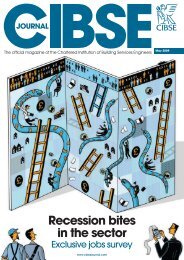You also want an ePaper? Increase the reach of your titles
YUMPU automatically turns print PDFs into web optimized ePapers that Google loves.
Professional<br />
development<br />
The <strong>CIBSE</strong> <strong>Journal</strong> CPD Programme<br />
Members of the Chartered Institution of Building Services Engineers (<strong>CIBSE</strong>) and<br />
other professional bodies are required to maintain their professional competence<br />
throughout their careers. Continuing professional development (CPD) means the<br />
systematic maintenance, improvement and broadening of your knowledge and<br />
skills, and is therefore a long-term commitment to enhancing your competence.<br />
CPD is a requirement of both <strong>CIBSE</strong> and the Register of the Engineering Council (UK).<br />
<strong>CIBSE</strong> <strong>Journal</strong> is ple<strong>as</strong>ed to offer this module in its CPD programme. The programme<br />
is free and can be used by any reader.<br />
This module will help you to meet <strong>CIBSE</strong>’s requirement for CPD. It will equally <strong>as</strong>sist<br />
members of other institutions, who should record CPD activities in accordance with<br />
their institution’s guidance.<br />
Simply study the module and complete the questionnaire on the final page,<br />
following the instructions for its submission. Modules will be available online at<br />
www.cibsejournal.com/cpd while the information they contain remains current.<br />
You can also complete the questionnaire online, and receive your results by return email.<br />
Indoor air quality<br />
Air quality is set to become even more significant in the work of the building professional,<br />
and this CPD article aims to provide an update on those parameters that are currently<br />
thought to contribute to indoor air quality<br />
The built environment is rightly<br />
focusing incre<strong>as</strong>ingly on energy<br />
efficiency. But it is important to<br />
remember that a primary purpose<br />
of the occupied building envelope is to<br />
provide a safe and comfortable environment<br />
for people – and this where internal air<br />
quality (IAQ) becomes a key consideration.<br />
Aside from the e<strong>as</strong>ily observable<br />
considerations of ‘b<strong>as</strong>ic’ occupant thermal<br />
comfort, the effects of the IAQ may have<br />
transitory or lifelong consequences for<br />
building users. Such effects can be highly<br />
visible (<strong>as</strong> with condensation or mould), or<br />
less so but e<strong>as</strong>ily me<strong>as</strong>urable (<strong>as</strong> with radon<br />
g<strong>as</strong> accumulation, for example). Some<br />
effects can go undetected and, <strong>as</strong> such, lead<br />
to environments that become linked to ‘sick<br />
building syndrome’. By maintaining good<br />
levels of IAQ, there are likely to be tangible<br />
financial benefits through incre<strong>as</strong>ed<br />
productivity and less workplace sickness [1] .<br />
As with any real-world design challenge,<br />
it is impossible to satisfy all occupants of a<br />
building in terms of IAQ. In his seminal<br />
work the late Ole Fanger [2] considered the<br />
integrating effects for thermal comfort.<br />
However, this did not include the effect<br />
of IAQ. His later work included the<br />
development of the ‘olf’, and he attempts<br />
to provide a numerical correlation<br />
between emissions and olfactory response<br />
(human sense of smell). This is a complex<br />
relationship: the ways that people perceive<br />
contaminants will itself be affected by<br />
the other room conditions including<br />
temperature, humidity and lighting, <strong>as</strong> well<br />
<strong>as</strong> personal preferences and susceptibilities.<br />
In addition, it is unlikely that<br />
contaminants in the air will be dispersed<br />
evenly in a space, thereby providing IAQ<br />
problem ‘hot spots’. In terms of comfort,<br />
there are published criteria [3] relating to<br />
subjective perception and the acceptable<br />
periods for discomfort.<br />
The principal contaminants that are<br />
<strong>as</strong>sociated with causing problems in IAQ<br />
(principally in terms of health) are:<br />
Particulates<br />
The focus here h<strong>as</strong> traditionally been<br />
on PM10, which refers to particles of less<br />
than 10 µm (micrometres). But attention<br />
h<strong>as</strong> incre<strong>as</strong>ingly been turning to PM2.5<br />
CPD Programme<br />
(< 2.5 µm) particles that are me<strong>as</strong>ured in<br />
µg/m 3 (micrograms per cubic metre).<br />
The recently published SNIFFER report 4<br />
on PM2.5 in the UK provides an extensive<br />
summary of the current state of scientific<br />
knowledge on PM2.5. It concludes that<br />
there are serious health consequences for<br />
long-term exposure to PM2.5 (small particles<br />
are <strong>as</strong>sociated with reduced lung function<br />
and incre<strong>as</strong>ed risk of heart and respiratory<br />
dise<strong>as</strong>e) and that currently no safe exposure<br />
limit is really known. The control of PM2.5<br />
in external air is complex because much is<br />
outside local control, although activities such<br />
<strong>as</strong> smoking [5] , vehicle emissions and a rise<br />
in the use of wood stoves have been shown<br />
to incre<strong>as</strong>e localised values. (EU directive<br />
50/2008 h<strong>as</strong> set a limiting value for PM2.5 of<br />
25 µg/m3 in outdoor air by 2015.)<br />
Tobacco smoke<br />
This is generally known <strong>as</strong> environmental<br />
tobacco smoke (ETS). Although not such a<br />
widespread risk in public are<strong>as</strong> in the UK,<br />
there are many places around the world (<strong>as</strong><br />
well <strong>as</strong> in domestic and other exceptions<br />
in the UK) where ETS is still a major<br />
www.cibsejournal.com April 2011 <strong>CIBSE</strong> <strong>Journal</strong> 53







